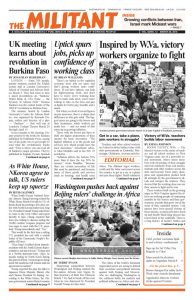Decadeslong conflicts between the capitalist rulers of Iran and Israel have sharpened as Tehran expands its military presence in Syria. At home the Iranian rulers confront growing working-class opposition to their wars abroad, and also to their enforcement of second-class status for women.
Israel’s indispensable place as a refuge for Jews in face of the global rise in Jew-hatred and anti-Semitic violence has been targeted by the counterrevolutionary rulers in Tehran for decades. Putting themselves and their Hezbollah allies in Lebanon in a better position to threaten the people of Israel has been a central goal driving their intervention in Syria.
Israeli officials say Tehran has established at least 10 military bases inside Syria, stationing Iranian Revolutionary Guard forces near the Israeli border. Tel Aviv responded rapidly to a drone dispatched into Israeli airspace by Iranian forces with airstrikes Feb. 10 on Iranian troops in Tiyas military airbase near Palmyra, Syria. Iranian Brig. Gen. Amir Ali Hajizadeh boasted March 7 that Tehran has increased its production of ballistic missiles threefold.
Washington and Tel Aviv demand Tehran restrict production of these weapons and end the presence of its military forces and militias in Syria. The U.S. rulers continue to deploy their own troops and massive firepower there to protect their imperialist interests in the region and to counter Tehran.
Revolution ousts U.S.-backed shah
Iranian workers and peasants rose up in a popular revolution in 1979, overthrowing the dictatorship of the U.S.-backed shah. The revolution opened up political space for workers, landless peasants, women, oppressed nationalities like the Kurds, and communists. Iran’s capitalist rulers, led by Shiite clerical forces, carried through a counterrevolution in the early 1980s to push back what working people had conquered.
To preserve their rule at home, the capitalist rulers have been driven to extend their counterrevolutionary influence abroad — backing Hezbollah and later intervening in bloody wars in Syria, Iraq and Yemen. Tehran-backed forces and Moscow’s airstrikes were decisive in shoring up the Bashar al-Assad dictatorship in Syria. Through its intervention there Tehran carved out a corridor to channel more advanced weapons to Hezbollah.
Tehran-backed militias are helping Assad retake parts of the Syrian Golan Heights, positioning their forces closer to Israel’s border. The rest of the Golan Heights was captured by Israel during its 1967 war against Egypt, Jordan and Syria. Tel Aviv provides aid to Syrian opposition forces that hold parts of the Syrian Golan Heights. The Israeli rulers seek to create a buffer between Israel and Iranian-backed forces operating in Syria.
Iran’s Supreme Leader Ayatollah Ali Khamenei has repeatedly called for the destruction of Israel, for driving the Jews into the sea. He denies that the Holocaust took place, the murder of 6 million Jews by Nazis in Germany and their thugs in Europe following a crushing defeat of the working class there. Tehran’s allies — from Hezbollah to Hamas, to those leading Houthi forces in Yemen — echo Khamenei’s Jew-hating tirades.
In response to Tehran’s rising military clout, the Israeli rulers have sought allies among Arab governments in the region. This includes the ruling capitalist monarchy in Saudi Arabia, which previously insisted that its relations with Tel Aviv depended on Israel’s withdrawal from territories seized during the 1967 war. Increasingly the Sunni rulers in Saudi Arabia and Tel Aviv share an interest in pushing back a common foe — Tehran. In November Israeli military chief Lt. Gen. Gadi Eisenkot told Saudi newspaper Elaph that Tel Aviv would share military intelligence with Riyadh to help curb Tehran.
The bourgeois rulers in Saudi Arabia have long shunned the state of Israel, claiming to speak for the Palestinian people who have been pushed into refugee camps across the region and Balkanized on the West Bank and Gaza Strip.
Road forward for toilers in Mideast
“Immediate talks to recognize both Israel and an independent Palestinian state” is a precondition for progress for working people in the Middle East, a Dec. 11, 2017, statement by the Socialist Workers Party National Committee explains.
“It is along this road that working people of all national backgrounds, religious beliefs and political allegiances in Israel and Palestine can use and defend their space to speak, organize and begin redressing the blood-drenched legacy of imperialist domination and capitalist exploitation,” the statement says. “These historic outrages include ruthless colonial and national oppression across the Arab and Muslim countries, as well as the genocidal crimes of the Holocaust, the murderous pogroms preceding it across Eastern and Central Europe and Russia, and the enduring reality of Jew-hatred in today’s crisis-ridden capitalist world.”
Conflicts between different wings of Iran’s capitalist rulers help keep space open for working people to advance their interests there. Khamenei blamed “ignorant” elites — rivals around President Hassan Rouhani — for encouraging recent protests against restrictive dress codes for women.
In February Rouhani, who was one of the architects of these restrictions, released a 2014 opinion poll showing that nearly half of those asked thought what women wear should be a private matter. The study also revealed a sharp decline since 2006 in the number of people who thought women should face charges and prison for not wearing a hijab.
Individual protests against anti-woman dress codes spread across the country earlier this year in the weeks following working-class unrest over the impact of Tehran’s wars.
Enforcing the clerics’ edicts on women’s attire was a product of the counterrevolution carried through by the country’s capitalist rulers, not a consequence of the 1979 revolution, as they are falsely described in the press. Millions of women participated in that working-class rebellion, gaining confidence to advance the fight for women’s rights. The regime wasn’t able to deny women the right to choose whether or not to wear the hijab until 1983. One product of the revolution that the rulers never reversed was the growing number of women who entered the workforce.
In the wake of the widespread December and January working-class protests against Tehran’s wars more unrest is percolating. The New York Times reports that hundreds of steelworkers employed at the Iran National Steel Group who had gone unpaid for months took strike action in early March.

